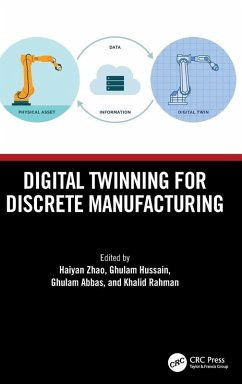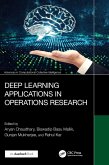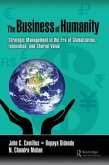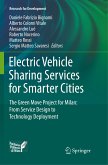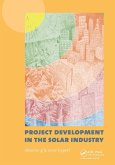Digital Twinning for Discrete Manufacturing
Herausgeber: Zhao, Haiyan; Abbas, Ghulam; Hussain, Ghulam
Digital Twinning for Discrete Manufacturing
Herausgeber: Zhao, Haiyan; Abbas, Ghulam; Hussain, Ghulam
- Gebundenes Buch
- Merkliste
- Auf die Merkliste
- Bewerten Bewerten
- Teilen
- Produkt teilen
- Produkterinnerung
- Produkterinnerung
This book addresses the Digital Twinning of manufacturing processes, cells, and systems and attempts to bring in the basic characteristics of the 4th Industrial Revolution along with an emphasis on Cyber-Physical Systems. It discusses how to maximize the use of the pillars of Industry 4.0 and 5.0 in discrete manufacturing.
Andere Kunden interessierten sich auch für
![Deep Learning Applications in Operations Research Deep Learning Applications in Operations Research]() Deep Learning Applications in Operations Research233,99 €
Deep Learning Applications in Operations Research233,99 €![Wood Pellet Heating Systems Wood Pellet Heating Systems]() Dilwyn JenkinsWood Pellet Heating Systems234,99 €
Dilwyn JenkinsWood Pellet Heating Systems234,99 €![The Business of Humanity The Business of Humanity]() John CamillusThe Business of Humanity58,99 €
John CamillusThe Business of Humanity58,99 €![Multi-Airfoil Design: Spectral Approach Multi-Airfoil Design: Spectral Approach]() NamitaMulti-Airfoil Design: Spectral Approach26,59 €
NamitaMulti-Airfoil Design: Spectral Approach26,59 €![Electric Vehicle Sharing Services for Smarter Cities Electric Vehicle Sharing Services for Smarter Cities]() Electric Vehicle Sharing Services for Smarter Cities106,99 €
Electric Vehicle Sharing Services for Smarter Cities106,99 €![Machine Learning, Advances in Computing, Renewable Energy and Communication Machine Learning, Advances in Computing, Renewable Energy and Communication]() Machine Learning, Advances in Computing, Renewable Energy and Communication226,99 €
Machine Learning, Advances in Computing, Renewable Energy and Communication226,99 €![Project Development in the Solar Industry Project Development in the Solar Industry]() Project Development in the Solar Industry156,99 €
Project Development in the Solar Industry156,99 €-
-
-
This book addresses the Digital Twinning of manufacturing processes, cells, and systems and attempts to bring in the basic characteristics of the 4th Industrial Revolution along with an emphasis on Cyber-Physical Systems. It discusses how to maximize the use of the pillars of Industry 4.0 and 5.0 in discrete manufacturing.
Produktdetails
- Produktdetails
- Verlag: Taylor & Francis Ltd (Sales)
- Seitenzahl: 246
- Erscheinungstermin: 28. November 2025
- Englisch
- Abmessung: 234mm x 156mm x 16mm
- Gewicht: 558g
- ISBN-13: 9781041004332
- ISBN-10: 1041004338
- Artikelnr.: 74516046
- Herstellerkennzeichnung
- Libri GmbH
- Europaallee 1
- 36244 Bad Hersfeld
- gpsr@libri.de
- Verlag: Taylor & Francis Ltd (Sales)
- Seitenzahl: 246
- Erscheinungstermin: 28. November 2025
- Englisch
- Abmessung: 234mm x 156mm x 16mm
- Gewicht: 558g
- ISBN-13: 9781041004332
- ISBN-10: 1041004338
- Artikelnr.: 74516046
- Herstellerkennzeichnung
- Libri GmbH
- Europaallee 1
- 36244 Bad Hersfeld
- gpsr@libri.de
Haiyan Zhao obtained his Ph.D. from the Department of Mechanical Engineering (Materials Science and Engineering), Xi'an Jiaotong University, in 1997. Earlier, he obtained his B.S. in Welding and Joining from the same University in 1992. He worked in the Department of Mechanical Engineering, Tsinghua University, as Assistant Professor, Associate Professor, and full Professor sequentially, 2000-Present. He was also a visiting professor at RWTH Aachen University, Germany, during 2004-2005. His research interests include Welding and Joining, Manufacturing by Materials Processing, Theory and Application of Modeling and Simulation, Structure Integrity, Service Life Prediction and Performance Evaluation, Prediction and Control of Residual Stress and Deformation, and Bio-Sensor based on Graphene. He was awarded the "New Century Excellent Talents" from the Ministry of Education, P.R. China in 2007, and "Excellent Teaching Achievement Award (the first prize)" from Tsinghua University in 2008. He also has numerous books, conference papers, and journal publications to his credit. Ghulam Hussain is a professor of mechanical engineering at the University of Bahrain, Bahrain. He has rich experience in both academia and industry. He is an expert in manufacturing technologies with expertise in plasticity, sustainability, and advanced processes, including 3D printing, incremental forming, friction welding, and hybridization. He is the author of over 100 top-notch journal articles and an editor of several books. He is recognized among the top 10 leading researchers at the international as well as the national level. He has been ranked as the world's top 2% scientist by Stanford University, USA. He is the winner of many research and teaching awards/prizes. He is actively involved with several reputed international universities as a foreign expert and external researcher. Ghulam Abbas received the B.S. degree in computer science from the University of Peshawar, Pakistan, in 2003, and the M.S. degree in distributed systems and the Ph.D. degree in computer networks from the University of Liverpool, U.K., in 2005 and 2010, respectively. From 2006 to 2010, he was a Research Associate with Liverpool Hope University, U.K., where he was associated with the Intelligent & Distributed Systems Laboratory. Since 2011, he has been with the Faculty of Computer Sciences & Engineering, GIK Institute of Engineering Sciences and Technology, Pakistan. He is currently working as Professor and Director of the Huawei ICT Academy. Dr. Abbas is a Co-Founding Member of the Telecommunications and Networking Research Center at GIK Institute. He is a Fellow of the Institute of Science & Technology, U.K., a Fellow of the British Computer Society, and a Senior Member of the IEEE. His research interests include computer networks and wireless and mobile communications. Khalid Rahman is a Professor in the Faculty of Mechanical Engineering at Ghulam Ishaq Khan Institute of Engineering Sciences and Technology, where he has been a faculty member since 2012. He received his B.S. in Mechanical Engineering from Ghulam Ishaq Khan Institute of Engineering Sciences and Technology, MS and PhD degrees from Jeju National University, South Korea in 2012. He also has industrial experience of seven years in design and manufacturing. His research interests include printing technologies, and he is currently working on Direct Ink Write and Electrohydrodynamic inkjet printing for the fabrication of electronic devices, sensors, and applications.
1. Digital Twinning: Origin, Basics and Standards. 2. Optimizing the
dependability of cyber-physical systems using Digital Twinning. 3. Digital
Twinning: Paradigm shift from Industry 4.0 to 5.0. 4. The Role of
Cybersecurity and Big Data in Digital Twinning: A Review, Challenges, and
Opportunities. 5. Mastering Machine Tools in the Digital Age: The Role of
Digital Twin in Modern Machine Tool Operations. 6. A Framework for
Autonomous Feedback Control from Digital Twin to Six Degree of Freedom
Machining Bed. 7. Process Design and Simulation for Digital Twinning of
Thixoforming. 8. Development of a Surface Sensing Tool for Normal
Measurement for Robotic Machining Tasks. 9. Digital Twin-Driven Approach to
Predict Cutting Forces and Temperature in Turning of Ti 6246 Alloy. 10.
Predictive Maintenance of Machine Tools Using Digital Twin. 11. Exploring
Contemporary Approaches to Machine Tool Maintenance: Leveraging Digital
Twins. 12. Benchmarking Sim2Real Gap: High-fidelity Digital Twinning of
Agile Manufacturing. 13. Roles of Digital Twin in Wireless Networks. 14.
Quantum Computing Digital Twin and Applications. 15. Schemes for
Cyber-secure manufacturing.
dependability of cyber-physical systems using Digital Twinning. 3. Digital
Twinning: Paradigm shift from Industry 4.0 to 5.0. 4. The Role of
Cybersecurity and Big Data in Digital Twinning: A Review, Challenges, and
Opportunities. 5. Mastering Machine Tools in the Digital Age: The Role of
Digital Twin in Modern Machine Tool Operations. 6. A Framework for
Autonomous Feedback Control from Digital Twin to Six Degree of Freedom
Machining Bed. 7. Process Design and Simulation for Digital Twinning of
Thixoforming. 8. Development of a Surface Sensing Tool for Normal
Measurement for Robotic Machining Tasks. 9. Digital Twin-Driven Approach to
Predict Cutting Forces and Temperature in Turning of Ti 6246 Alloy. 10.
Predictive Maintenance of Machine Tools Using Digital Twin. 11. Exploring
Contemporary Approaches to Machine Tool Maintenance: Leveraging Digital
Twins. 12. Benchmarking Sim2Real Gap: High-fidelity Digital Twinning of
Agile Manufacturing. 13. Roles of Digital Twin in Wireless Networks. 14.
Quantum Computing Digital Twin and Applications. 15. Schemes for
Cyber-secure manufacturing.
1. Digital Twinning: Origin, Basics and Standards. 2. Optimizing the
dependability of cyber-physical systems using Digital Twinning. 3. Digital
Twinning: Paradigm shift from Industry 4.0 to 5.0. 4. The Role of
Cybersecurity and Big Data in Digital Twinning: A Review, Challenges, and
Opportunities. 5. Mastering Machine Tools in the Digital Age: The Role of
Digital Twin in Modern Machine Tool Operations. 6. A Framework for
Autonomous Feedback Control from Digital Twin to Six Degree of Freedom
Machining Bed. 7. Process Design and Simulation for Digital Twinning of
Thixoforming. 8. Development of a Surface Sensing Tool for Normal
Measurement for Robotic Machining Tasks. 9. Digital Twin-Driven Approach to
Predict Cutting Forces and Temperature in Turning of Ti 6246 Alloy. 10.
Predictive Maintenance of Machine Tools Using Digital Twin. 11. Exploring
Contemporary Approaches to Machine Tool Maintenance: Leveraging Digital
Twins. 12. Benchmarking Sim2Real Gap: High-fidelity Digital Twinning of
Agile Manufacturing. 13. Roles of Digital Twin in Wireless Networks. 14.
Quantum Computing Digital Twin and Applications. 15. Schemes for
Cyber-secure manufacturing.
dependability of cyber-physical systems using Digital Twinning. 3. Digital
Twinning: Paradigm shift from Industry 4.0 to 5.0. 4. The Role of
Cybersecurity and Big Data in Digital Twinning: A Review, Challenges, and
Opportunities. 5. Mastering Machine Tools in the Digital Age: The Role of
Digital Twin in Modern Machine Tool Operations. 6. A Framework for
Autonomous Feedback Control from Digital Twin to Six Degree of Freedom
Machining Bed. 7. Process Design and Simulation for Digital Twinning of
Thixoforming. 8. Development of a Surface Sensing Tool for Normal
Measurement for Robotic Machining Tasks. 9. Digital Twin-Driven Approach to
Predict Cutting Forces and Temperature in Turning of Ti 6246 Alloy. 10.
Predictive Maintenance of Machine Tools Using Digital Twin. 11. Exploring
Contemporary Approaches to Machine Tool Maintenance: Leveraging Digital
Twins. 12. Benchmarking Sim2Real Gap: High-fidelity Digital Twinning of
Agile Manufacturing. 13. Roles of Digital Twin in Wireless Networks. 14.
Quantum Computing Digital Twin and Applications. 15. Schemes for
Cyber-secure manufacturing.

